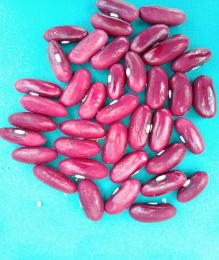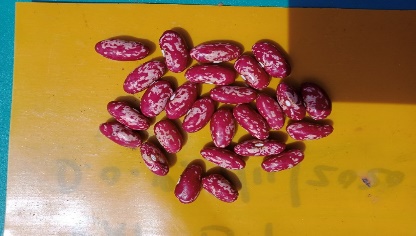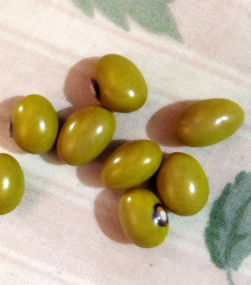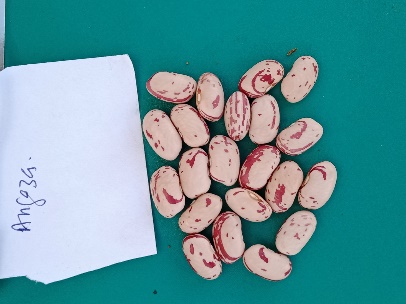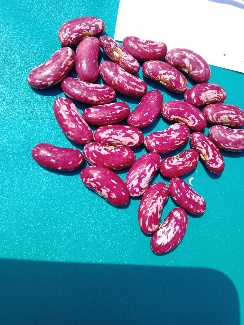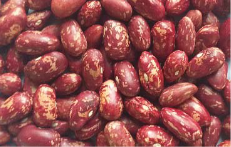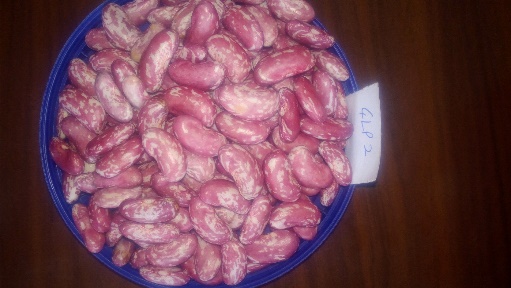Dry Beans TIMPs
Introduction
Common bean or dry beans (Phaseolus vulgaris) is an annual legume crop mainly grown for its grain. It is the third most important food crop in Kenya after maize and Irish potatoes.
The grains are rich source of cheap protein (20‐28%), energy (32%), fibre (56%) and micronutrients especially iron (70 mg/kg) and zinc (33 mg/kg) and vitamin A.
The grains can be boiled and prepared into stews or broth and served with ugali, cassava, rice or banana. Alternatively, they can be boiled together with staple food such as maize, banana or cassava.
In Kenya, the crop is grown in an area of 1.1 million ha, producing about 0.76 million tons of dry grain valued at KES 60 billion annually.
Bean production is mainly at subsistence level by small-scale farmers but commercialization is increasing in the recent past.
Productivity of beans can be enhanced with the use of improved varieties in combination with the recommended agronomic practices.
Common bean improved varieties include:
Nyota, Kat B1, Faida, Angaza, KK15, KK Rose coco 194, Mac 64 (Kenya Mavuno) ,Mac 34 (Kenya Tamu), KK Red 16, GLP 2 (Rose coco), GLPx92 (Mwitemania), Kat B9, Katram, Katx69, GLP585 (Wairimu),Chelalang,Tasha,Ciankui,Miezi mbili,Mwezi Moja GLP1004,New Mwezi Moja GLP1127a,
Site selection
- Beans grow on a wide range of soil types but best growth is obtained in well-drained soils with high organic matter.
- Avoid steeply sloping land, areas near a swamp, very sandy soil and areas with shallow surface soil and a lot of couch grass.
Altitude range
- Beans require altitudes of 1000 – 2000m above sea level.
Soil type and conditions
- Well-drained soils with a soil pH: 6.0 – 7.0.
Temperature range
- Bean crop thrives in a warm climate at optimal temperatures of 18 to 24 °C.
- High day temperatures exceeding 30°C during flowering stage lead to dropping of flowers, low pod set, and malformed beans resulting in yield loss.
- Day temperatures below 20 °C delays maturity and seed formation causing pods to mature empty.
Rainfall
- Annual total rainfall of 600 to 1500 mm is considered as ideal for bean production. The rainfall should be well-distributed during crop cycle.
- Too much rain and long spells of drought lead to reduced grain yields.
Selection of varieties
- Select bean varieties with high yield potential, good tolerance to prevailing adverse environmental conditions such as drought and low soil fertility, good tolerance to pests and diseases and with high market acceptability.
- Some common bean varieties released by KALRO include:
|
Variety name |
Optimal altitude (Range Masl) |
Duration of maturity months |
Grain yield (90 kg bags /acre) |
Special attribute |
|
KatX56
|
900-1800 |
2.5-3 |
6.6-8 |
|
|
Nyota
|
900-1800 |
2.5-3 |
6-9 |
|
|
Kat B1
|
900-1600 |
2.5 |
5.3-6.6 |
|
|
KK red 16
|
1500-1800 |
2.5 |
8-10 |
|
|
Angaza
|
1200-1900 |
2.5-3 |
6-12 |
|
|
Faida
|
1300-2000 |
2.5-3 |
6-10 |
|
|
GLPx92
|
900-1600 |
2-3 |
5-7 |
|
|
Kenya Mavuno (Mac 64)
|
1400-2000 |
3-5 |
9-13 |
|
|
GLP 2 (Rosecoco)
|
1500-2000 |
2.5-3 |
8-10 |
|
Spacing
- Appropriate plant spacing minimizes competition for nutrition, light and water.
- For bush beans, use a spacing of 50 x 10 cm under mono-cropping (pure stand) system. If intercropping with maize, plant maize at the recommended spacing for the area followed by planting 2 equidistant bean rows between the maize rows at 15cm within rows, one seed per hill. Alternatively, plant one bean row between maize rows, two seeds per hill.
- For climbing beans use a spacing of 75 x 15 cm apart (1 seed per hill) or 75 x 25 cm (2 seeds per hill).
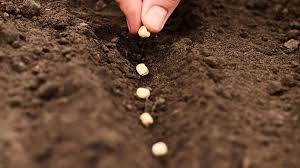
Planting beans in furrows
Seed rate
- One acre of land requires 16-30 kg of seed depending on seed size. Large seeded varieties require 25-30 kg while the small sized require 16-20 kg/acre.
Bench terraces
- Make bench terraces to plant beans in areas with steep slopes.
- Bench terraces consist of a series of beds which are more or less level running across a slope at vertical intervals, supported by steep banks or risers (walls).
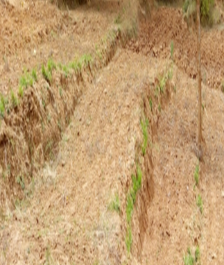
Bench terraces in Makueni County
Mulching
- Mulching conserves soil moisture, improves soil structure, limits weed growth and controls soil erosion.
- Crop residues such as coffee husks, maize Stover and sorghum Stover can be used as mulch.
- Apply the mulch 2-3 weeks after crop emergence.
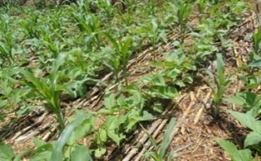
Mulching bean crop with maize stover
- Beans crop requires to be supplied with sufficient nutrients, both macro and micro nutrient elements for optimum growth.
- Soil fertility can be improved through application of organic fertilizers/manures and inorganic or chemical fertilizers.
- Soil testing is recommended for proper decision on what type of soil fertility to apply.
Organic fertilizers/manure
- Well decomposed manure, is spread evenly in the planting furrows and mixed with the soil one week before seeds are sown. The required quantity of manure is 6-8 tons per acre.
Inorganic fertilizers
- Inorganic compound fertilizers such as NPK (20:20:0 or 23:23:0 or Mavuno) can be applied at planting at a rate of 1 - 1½ bags (50-75 kg) per acre depending on the soil fertility. The fertilizer should be applied at the planting furrow and thoroughly mixed with soil before covering the seed.
Foliar fertilizers
- Foliar fertilizers supply to plants essential micronutrients such as boron, Zinc and copper.
- Gapping entails replanting seeds to fill up empty spaces as a result of un-germinated seeds.
- Gapping should be done 2 weeks after planting.

Emerging bean seedlings
Topdressing
- Spray foliar fertilizers during vegetative stage (3-4 weeks after planting), flowering and early poding growth stages (5-6 weeks after planting) for healthy, vigorous crop and high yields.
Weed control
- Weeds compete with the bean crop for nutrients, light and water resulting in reduced yield. Timely and thorough weeding is therefore absolutely essential.
- Carry out the first weeding 2-3 weeks after emergence followed by a second weeding 3 weeks later (just before flowering) in mono-cropping.
- In intercropping, one weeding 3 weeks after planting may be sufficient except in high rainfall areas where a second selective weeding 3 weeks later may be necessary.
- Take care to avoid damaging the shallow roots especially during the first weeding. Avoid weeding during flowering time to avoid mechanical damage of flowers.
- Alternatively, use selective herbicides such as Bentazone about 2 weeks after crop emergence to control the weeds. To achieve good results, apply the herbicide when the weeds are still young and tender.
Supporting climbing beans
- Supports of up to 3m are recommended for climbing beans. Provide supports within 1-2 weeks after emergence to have the young bean plants climbing and branching early enough.
- The common support methods include:
- One stick for two plants at each planting hill.
- Posts and wire or string structure.
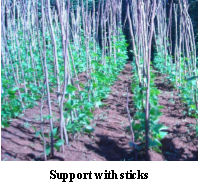
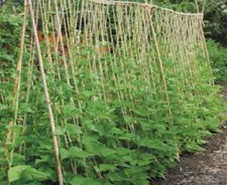
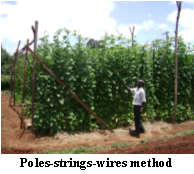
Stick support methods Posts and string method Posts and wire method
Rogueing
- Identify and uproot plants with undesirable characteristics from fields. This includes both the off types and diseased plants.
- Rogueing helps to preserve the quality of the crop being grown. Rouging is done throughout the crop cycle.
Crop rotation
Practice crop rotation after two seasons with non-legumes such as cereals
Arthropod Pests
Cut worm
- Damage is on young seedlings which are cut near the ground.
- On digging into the soil near the cut plants one may find a dull, plump, hairless brown, charcoal gray, or black larva about 3 cm long.
- The larva curls up tightly when disturbed.
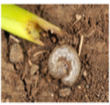
Cutworm larva
Management:
- Cutworm is a minor pest in beans but where population is high, the larvae can be baited with straw mixed with an insecticide and molasses and sprayed within the field.
- Prepare land early to expose caterpillars in the soil to predators and to desiccation by the sun.
- Apply ash around the emerging plants.
- Use neem based botanical insecticides.
- Spray Lambda Cyhalothrin based products to control the cutworms.
Bean Stem Maggots (Bean Fly) Ophiomyia spp
- This is a serious common bean pest that can cause severe damage and yield losses.
- The adult bean fly lays egg on the leaves of emerging plants. The larval tunnels through the stem and pupate near the soil level causing the stem to crack.
- The young seedlings wilt and die and the older plants become stunted.

Management
- Early planting to avoid season of high maggot populations, uproot and destroy infested plants by burning.
- Grow beans in more healthy and fertile soils.
- Mulching with materials such as rice straw to enhance adventitious root formation.
- Dress the seeds with systemic insecticides such as Acephate, before planting to protect the young seedlings.
Pod sucking bugs (Clavigralla spp)
- Some adults Clavigralla sp are stout, furry and about 10 mm long and brown in colour while other species are smaller, grey and have a pair of elongated spines on their shoulders.
- The bugs pierce the pod walls and suck the developing seeds. This leaves tiny depressions or dimples on the pod wall.
- The seed rots or shrivels and loses viability. The whole pod may shriv
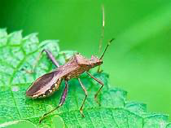
Adult pod sucking bug (Clavigralla tomentosicollis)
Management
- Conserve natural enemies such as the assassin bugs, spiders, praying mantises and ants.
- Botanical pesticides such as neem seed kernel extract and other concoctions such as fermented cow urine may also repel the adults and nymphs.
- Use of pesticide sprays, such as Cypermethrin and Imidacloprid to control early instar nymphs. Spray in the morning when the immature stages are more exposed.
Black bean aphid (Aphis fabae)
- Initial colonization is by the migratory winged forms which produce black, soft, pear shaped, wingless nymphs.
- The nymphs are female and reproduce without mating.
- Nymphs have piercing mouthparts used suck saps from leaves and young shoots. This results in leaf curling and distortion especially on the young leaves.
- Other symptoms include leaf yellowing and wilting.
- Aphids are also vectors of virus diseases, such as the bean common mosaic virus (BCMV)
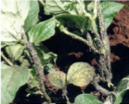
Bean plant heavily infested by aphids
Management
- Practise early planting in the season and destroy volunteer crops and weeds that act as alternate host in the farm.
- Crop rotate with non-legume family crops to avoid high pest build up.
- Conserve the natural enemies such as lady bird and parasitic wasps by managing foliar insecticides.
- Conduct regular scouting in the field for early identification and control of aphid infestation before they multiply and infest the entire field.
- Spot spray aphid infested areas only instead of the entire field.
- Under heavy infestation, spray with neem based biospesticides at recommended rate.
- Use other insecticides such as Acephate, Lambda-cyhalothrin, Chlorypirifos and Acetamiprid based products.
Pod borers
- A full grown caterpillar has a pale body lined by rows of visible black spots on its upper side.
- The caterpillar feeds on leaves, flowers, terminal buds and pods causing round holes. The Presence of faeces are evident on the surface of the infested plants.
Management
- Avoid planting susceptible crops adjacent to each other.
- Deep plough the soils after harvesting to expose the pupae to predators.
- Crop rotate legumes with cereal crops such as maize and wheat.
- Spray Deltamethrin and Bifenthrin based products.
Plant diseases
Bean Rust
- Raised orange to yellow powdery pustules mainly on leaves.
- In severe cases stems and pods are affected and leaves may fall off prematurely.
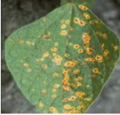
Rust spots on the leaves of the beans (Source: https://r.search.yahoo.com)
Management
- Use certified seeds
- Plant resistant varieties e.g. New mwezi moja.
- Practice crop rotations with non-legumes for 2-3 seasons.
- Uproot and destroy severely affected plants including weeds and volunteers by burning or burying deep.
- Avoid working in the farm when the conditions are wet.
- Spray with copper based fungicides.
Bean anthracnose (Colletotrichum lindemuthianum).
- Anthracnose is a major disease in all bean growing areas that causes significant yield losses.
- The disease is spread by rain splash, wind-blown rain and movement of insects, animals and man, especially when plant foliage is moist.
- It’s seed-borne and common in areas where farmers recycle own saved seeds.
- It’s one of the quarantine diseases that leads to rejection of seed bean crop during inspection by KEPHIS.
- Anthracnose is characterized by dark brown sunken spots on the pods. Dark reddish brown lesions appear along the underside veins of a leaf.


Bean pod and leaves affected by anthracnose
Management
- Use certified seed and crop rotate beans with cereals for a period of 3 to 4 seasons.
- Remove and destroy by burning all infected plants.
- Treat seeds with recommended seed dressing fungicides when not using certified seed.
- Spray the crop with carbendazim or azoxystrobin based products.
Angular leaf spot (ALS)
- The disease starts with round lesions which usually appear as grey spots and later turn brown. The spots are enclosed by leaf veins, giving the spot a typical angular shape.
- On the stem and pods, round spots may appear but in severe cases the leaves fall. Infected pods may bear poorly developed, shrivelled or discoloured seeds.
- Plant debris and infected volunteer plants are the major source of infection.
- The disease is spread by contaminated equipment, clothing, splashes of water and windblown rain.

Angular leaf spot infected leaves and pods
Management
- Crop rotate beans with cereal crops such as maize for at least 4 seasons.
- Seed dressing with suitable fungicides.
- Plant certified seeds.
- Avoid movement in the bean fields when the plants are wet
- Plant resistant cultivars such as Katram, New rosecoco and GLP24.
Common bacterial blight (CBB)
- Characterized by water soaked spots on leaves/pods. Large-brown spots of dead tissue usually appear on the pods.
- Plant appears burnt and dead but leaves remain attached.
- The bacterial blight spreads fast during wet weather condition.

Management
- Use certified seeds.
- Practice crop rotation with non-leguminous crops for 2-3 years.
- Uproot and destroy infected plants/ volunteers by burning.
- Disinfect farm tools in sodium hypochlorite solution.
Apply copper based fungicides
Halo blight
- Small watery brown spots on leaves surrounded by a yellow ring. This is followed by the entire leaf turning yellow.
- Oval greasy water-soaked spots on pods which become sunken reddish/brown in colour.
- Affects seed and favoured by cold weather.


Halo blight symptoms on leaves and pods
Management
- Use certified seeds.
- Practice crop rotation with non-leguminous crops for 2-3 yrs.
- Uproot and destroy infected plants/ volunteers by burning.
- Disinfect farm tools in sodium hypochlorite solution.
- Apply copper based fungicides.
Harvest beans when all the pods have turned yellow, but before they have become so dry that the pods begin to shatter or rot away in the field.

Beans crop ready for harvest in farmers field
One can tell when the beans are dry by the loud, sharp noise they make when dropped on the ground.
- The harvested crop is dried in sun by spreading on a plastic sheets or jute bags.
- If experiencing a spell of rain late in the season once pods have matured, plants can be removed from ground and hung upside down indoors or corridors to allow drying to continue.
- The harvested crop is dried in sun by spreading on a plastic sheets or jute bags.
- If experiencing a spell of rain late in the season once pods have matured, plants can be removed from ground and hung upside down indoors or corridors to allow drying to continue.

- Test the moisture of the seed before threshing using teeth or pinching the seed with fingers.
- Dry beans should crack with a loud sound when bitten and not brittle. Brittle beans should be dried further.

Threshing
- Dried beans can be piled inside jute bags and hit with sticks slowly to split them open without damaging the seeds.
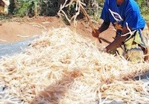
Manual threshing of beans on a plastic sheet
- Use mechanized bean threshers for faster threshing and winnowing.
- Dry the threshed grain further to reduce moisture content before storage. The grains are dried on mats, plastic sheets or wire mesh trays raised on a platform.

Drying threshed beans in the sun
Winnowing and sorting
- Winnow and sort the dry grains to remove chaff, dust, foreign matter such as stones, broken grains, shrivelled, mouldy, insect damaged, rotten discoloured or faded, and any remaining plant parts grains.

Storage
- Bean weevils (bruchids) are major storage pests of beans and can cause significant postharvest losses. Dust the bean grains with the recommended insecticides before storage to avoid bruchids damage.
- Pack the treated grains in disinfected gunny bags and store the bags in a non-leaking, clean and well ventilated storehouse.
- Place the bags at least 1 meter away from the walls and on a raised platform to avoid contact with moisture.
- The grains can also be kept in airtight drums or hermetic bags.
- Avoid extended storage of seeds to be used for planting in airtight containers because it can lower their viability.
- Bean seeds for next season’s planting can be mixed with dried leaves of marigold, tephrosia, neem or any other locally tried plant to prevent bruchids damage and stored in gunny bags.
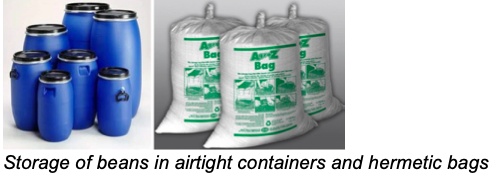
Transportation to the market
- The harvested beans can be transported to the market on head loads if the homestead is not far from the market, while larger quantities are transported by pick-ups, bicycle, motor bikes, wheel burrow and oxen or donkey carts.
Bean markets include
- Retailers.
- Wholesalers.
- Processors.
- Exporters.
- Offtakers.
- Supermarkets.
- Institutions such as schools, prisons, hospitals.
- Karanja D. et al. (2021). KALRO, KCSAP Inventory of climate smart agriculture dry bean technologies, innovations & management practices. Kenya Agricultural and Livestock Research Organization, Nairobi, Kenya.
- Esilaba, A.O.et al. (2021). KCEP-CRAL Common Dry Bean Extension Manual. Kenya Agricultural and Livestock Research Organization, Nairobi, Kenya.
- National crop variety list (2019). Kenya plant Health inspectorate services (KEPHIS)
- Esilaba, A.O. et al. (2021). KCEP–CRAL Farmers’ Extension Handbook. Kenya Agricultural and Livestock Research Organization, Nairobi, Kenya.
- Buruchara, R., Mukankusi, C., & Ampofo, K. (2010). Bean disease and pest identification and management- handbook for small-scale seed producers. International Center for Tropical Agriculture.
Kenya Agricultural and Livestock Research Organization
P.O. Box 57811-00200, Nairobi, Kenya
Call Centre No: 0111010100
